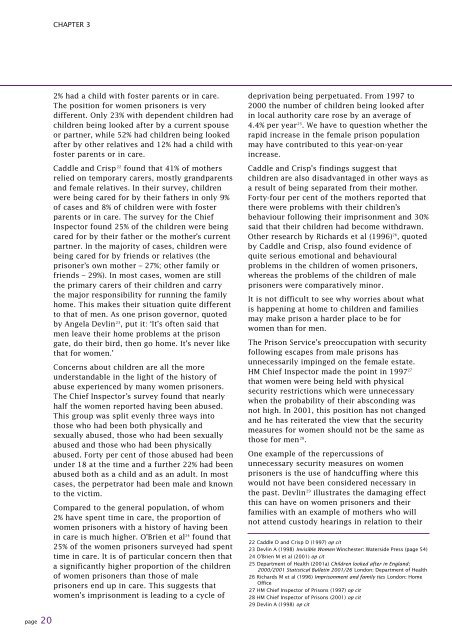Women who challenge - Nacro
Women who challenge - Nacro
Women who challenge - Nacro
- No tags were found...
You also want an ePaper? Increase the reach of your titles
YUMPU automatically turns print PDFs into web optimized ePapers that Google loves.
CHAPTER 32% had a child with foster parents or in care.The position for women prisoners is verydifferent. Only 23% with dependent children hadchildren being looked after by a current spouseor partner, while 52% had children being lookedafter by other relatives and 12% had a child withfoster parents or in care.Caddle and Crisp 22 found that 41% of mothersrelied on temporary carers, mostly grandparentsand female relatives. In their survey, childrenwere being cared for by their fathers in only 9%of cases and 8% of children were with fosterparents or in care. The survey for the ChiefInspector found 25% of the children were beingcared for by their father or the mother’s currentpartner. In the majority of cases, children werebeing cared for by friends or relatives (theprisoner’s own mother – 27%; other family orfriends – 29%). In most cases, women are stillthe primary carers of their children and carrythe major responsibility for running the familyhome. This makes their situation quite differentto that of men. As one prison governor, quotedby Angela Devlin 23 , put it: ‘It’s often said thatmen leave their home problems at the prisongate, do their bird, then go home. It’s never likethat for women.’Concerns about children are all the moreunderstandable in the light of the history ofabuse experienced by many women prisoners.The Chief Inspector’s survey found that nearlyhalf the women reported having been abused.This group was split evenly three ways intothose <strong>who</strong> had been both physically andsexually abused, those <strong>who</strong> had been sexuallyabused and those <strong>who</strong> had been physicallyabused. Forty per cent of those abused had beenunder 18 at the time and a further 22% had beenabused both as a child and as an adult. In mostcases, the perpetrator had been male and knownto the victim.Compared to the general population, of <strong>who</strong>m2% have spent time in care, the proportion ofwomen prisoners with a history of having beenin care is much higher. O’Brien et al 24 found that25% of the women prisoners surveyed had spenttime in care. It is of particular concern then thata significantly higher proportion of the childrenof women prisoners than those of maleprisoners end up in care. This suggests thatwomen’s imprisonment is leading to a cycle ofdeprivation being perpetuated. From 1997 to2000 the number of children being looked afterin local authority care rose by an average of4.4% per year 25 . We have to question whether therapid increase in the female prison populationmay have contributed to this year-on-yearincrease.Caddle and Crisp’s findings suggest thatchildren are also disadvantaged in other ways asa result of being separated from their mother.Forty-four per cent of the mothers reported thatthere were problems with their children’sbehaviour following their imprisonment and 30%said that their children had become withdrawn.Other research by Richards et al (1996) 26 , quotedby Caddle and Crisp, also found evidence ofquite serious emotional and behaviouralproblems in the children of women prisoners,whereas the problems of the children of maleprisoners were comparatively minor.It is not difficult to see why worries about whatis happening at home to children and familiesmay make prison a harder place to be forwomen than for men.The Prison Service’s preoccupation with securityfollowing escapes from male prisons hasunnecessarily impinged on the female estate.HM Chief Inspector made the point in 1997 27that women were being held with physicalsecurity restrictions which were unnecessarywhen the probability of their absconding wasnot high. In 2001, this position has not changedand he has reiterated the view that the securitymeasures for women should not be the same asthose for men 28 .One example of the repercussions ofunnecessary security measures on womenprisoners is the use of handcuffing where thiswould not have been considered necessary inthe past. Devlin 29 illustrates the damaging effectthis can have on women prisoners and theirfamilies with an example of mothers <strong>who</strong> willnot attend custody hearings in relation to their22 Caddle D and Crisp D (1997) op cit23 Devlin A (1998) Invisible <strong>Women</strong> Winchester: Waterside Press (page 54)24 O’Brien M et al (2001) op cit25 Department of Health (2001a) Children looked after in England;2000/2001 Statistical Bulletin 2001/26 London: Department of Health26 Richards M et al (1996) Imprisonment and family ties London: HomeOffice27 HM Chief Inspector of Prisons (1997) op cit28 HM Chief Inspector of Prisons (2001) op cit29 Devlin A (1998) op citpage 20
















